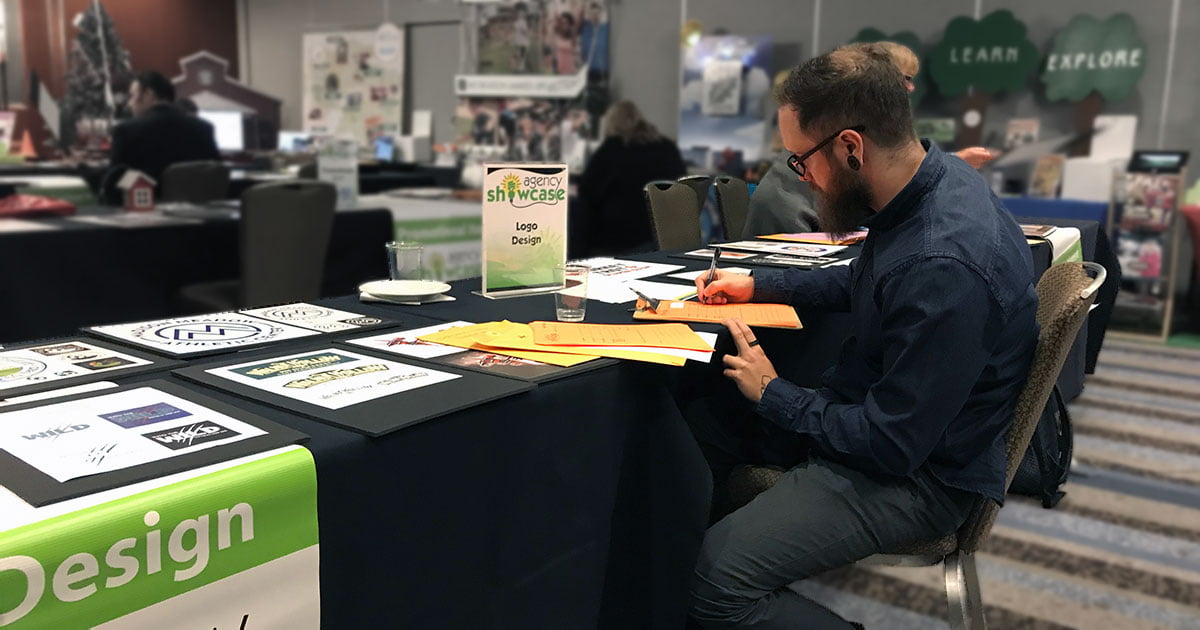Idea Marketing Group graphic designers, Erin Karper and Sean Moran were invited to judge submissions at the Illinois Parks and Recreation Association (IPRA) Conference in Chicago. Erin judged the Print Communication (Promotional) category and Sean judged the Logo Design category.
Pro Tip: Be bold with your print designs, but keep the info simple
Submitted print communication pieces included promotional posters, postcards, newsletters, fliers, and pamphlets with a clear call to action.
Each of the 18 pieces Erin judged was graded based on creativity, grammar, brand recognition, use of color, and overall campaign success. She noted the goal for most organizations was to increase attendance at community events and programmatic classes throughout the year.
“I was impressed by how organizations used different colors and fonts, but still kept a cohesive and fun look,” Erin said. “I can see how the designs could easily appeal to children, but also looked very professional for adults.”
She also noted a few areas for improvement.
…the reader should be directed to the organization’s website with a concise call to action.
Erin Karper
“A few of the designs looked outdated because of the choice of faded pastel colors and multiple font styles instead of bright, fun, upbeat colors and fewer font variations,” Erin said. “We also see organizations trying to fit too much information into a small print piece. Instead, the reader should be directed to the organization’s website with a concise call to action.”
Graphic Design Best Practices
The parks and recreation industry is fun and family focused. But, you don’t have to be a trained, corporate graphic designer in order to create well-designed, functional marketing materials. Just follow these general graphic design tips:
- Don’t be afraid to use bright bold colors, but limit it to a few; Same goes with fonts–try to be consistent;
- Above all, consider the reader’s ability to quickly make sense of the messaging hierarchy (What’s most important, what’s the call to action, etc.)
- When you have a lot of information to share, use your website as the place to direct people, not a small print piece.

Pro Tip: Define expectations with a thoughtful logo design
In the Logo Design category, Sean leaned on his expertise in user experience design to judge more than 20 designs at the IPRA Conference.
Organizations created logos to raise awareness for and increase attendance at community events, such as 5k runs after seeing a recent drop off in numbers. Designs were judged based on adaptability, scalability, creativity, and usage of color, typefaces, and illustration.
Sean noted how design professionalism makes a huge impact.
You’re defining who you are in a single graphic, don’t underestimate its impact.
Sean Moran
“When you’re making a logo for an event, you’re trying to stand out, but you’re also setting expectations in advance,” he said. “You’re defining who you are in a single graphic, don’t underestimate its impact.”
“Organizations should pay attention to what every detail of their design says consciously and subconsciously,” he added. “That process begins with a well thought out strategy, whether they’re designing a new logo in-house or hiring an outside firm or freelance designer.”
Here’s how Sean recommends organizations approach a logo design project:
- Know your audience.
- Don’t try to say too much.
- Understand current and past design trends. Design ahead of the curve to stay relevant and exciting.
- Remember, a logo needs to be digested just as well at 1x1in as it does at 10x10ft.
Conclusion
Whether your organization is creating printed promotional materials or creating a new logo, the goal is to strike a balance between art, science, and functionality. Professional graphic designers like Erin and Sean understand these nuances. If your park district doesn’t have designers in-house, consider hiring an outside firm or a freelance designer.
Digital design software (Canva, Publisher, etc.) can give amateurs the tools they need to create do-it-yourself materials. But, highly trained professionals provide the knowledge, vision and strategic thinking that ensures your design will engage your target audience, rather than simply look good on the page.
To read more about how Idea Marketing Group partners with park districts, as well as tourism and recreation organizations, check out our website design portfolio.




